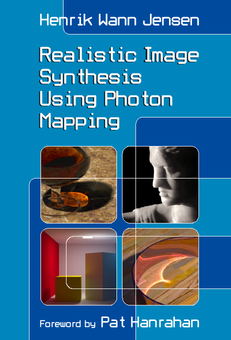The creation of photorealistic images of three-dimensional models is central to
computer graphics. Photon mapping, an extension of ray tracing, makes it
possible to efficiently simulate global illumination in complex scenes. Photon
mapping can simulate caustics (focused light, like shimmering waves at the
bottom of a swimming pool), diffuse inter-reflections (e.g., the "bleeding" of
colored light from a red wall onto a white floor, giving the floor a reddish
tint), and participating media (such as clouds or smoke). This book is a
practical guide to photon mapping; it provides both the theory and the
practical insight necessary to implement photon mapping and simulate all types
of direct and indirect illumination efficiently.
Contents
1. Introduction
1.1 Realistic Image Synthesis
1.2 Global Illumination
1.3 Overview of this Book
2. Fundamentals of Global Illumination
2.1 The Nature of Light
2.2 Lighting Terminology
2.3 Light Emission
2.4 Light Scattering
2.5 The Rendering Equation
2.6 Light Transport Notation
3. Monte Carlo Ray Tracing
3.1 Classic Ray Tracing
3.2 Path Tracing
3.3 Bidirectional Path Tracing
3.4 Metropolis Light Transport
4. The Photon Mapping Concept
4.1 Motivation
4.2 Developing the Model
4.3 Overview
5. Photon Tracing
5.1 Photon Emission
5.2 Photon Scattering
5.3 Photon Storing
6. The Photon Map Data Structure
6.1 The Data Structure
6.2 Photon Representation
6.3 The Balanced Kd-Tree
6.4 Locating the Nearest Photons Efficiently
7. The Radiance Estimate
7.1 Density Estimation
7.2 Derivation
7.3 Algorithm
7.4 Filtering
7.5 Photon Gathering
8. Visualizing the Photon Map
8.1 Rendering Caustics
8.2 Rendering Color Bleeding
8.3 Fast Approximations
8.4 Caustics Examples
9. A Practical Two-Pass Algorithm
9.1 Overview
9.2 Solving the Rendering Equation
9.3 Pass 1: Photon Tracing
9.4 Pass 2: Rendering
9.5 Examples
10. Participating Media
10.1 Light Scattering in Participating Media
10.2 The Volume Rendering Equation
10.3 The Phase Function
10.4 Ray Marching
10.5 Photon Tracing
10.6 The Volume Radiance Estimate
10.7 Rendering Participating Media
10.8 Subsurface Scattering
10.9 Examples
11. Optimization Strategies
11.1 Irradiance Caching
11.2 Importance Sampling
11.3 Visual Importance
11.4 Efficient Stratification of Photons
11.5 Faster Shadows with Shadow Photons
11.6 Precomputed Irradiance
11.7 Parallel Computations
A. Basic Monte Carlo Integration
A.1 The Sample Mean Method
A.2 Variance-Reduction Techniques
B. A Photon Map Implementation in C++
C. A Cognac Glass Model
Bibliography
Index
Last update: September 12, 2005
Henrik Wann Jensen
